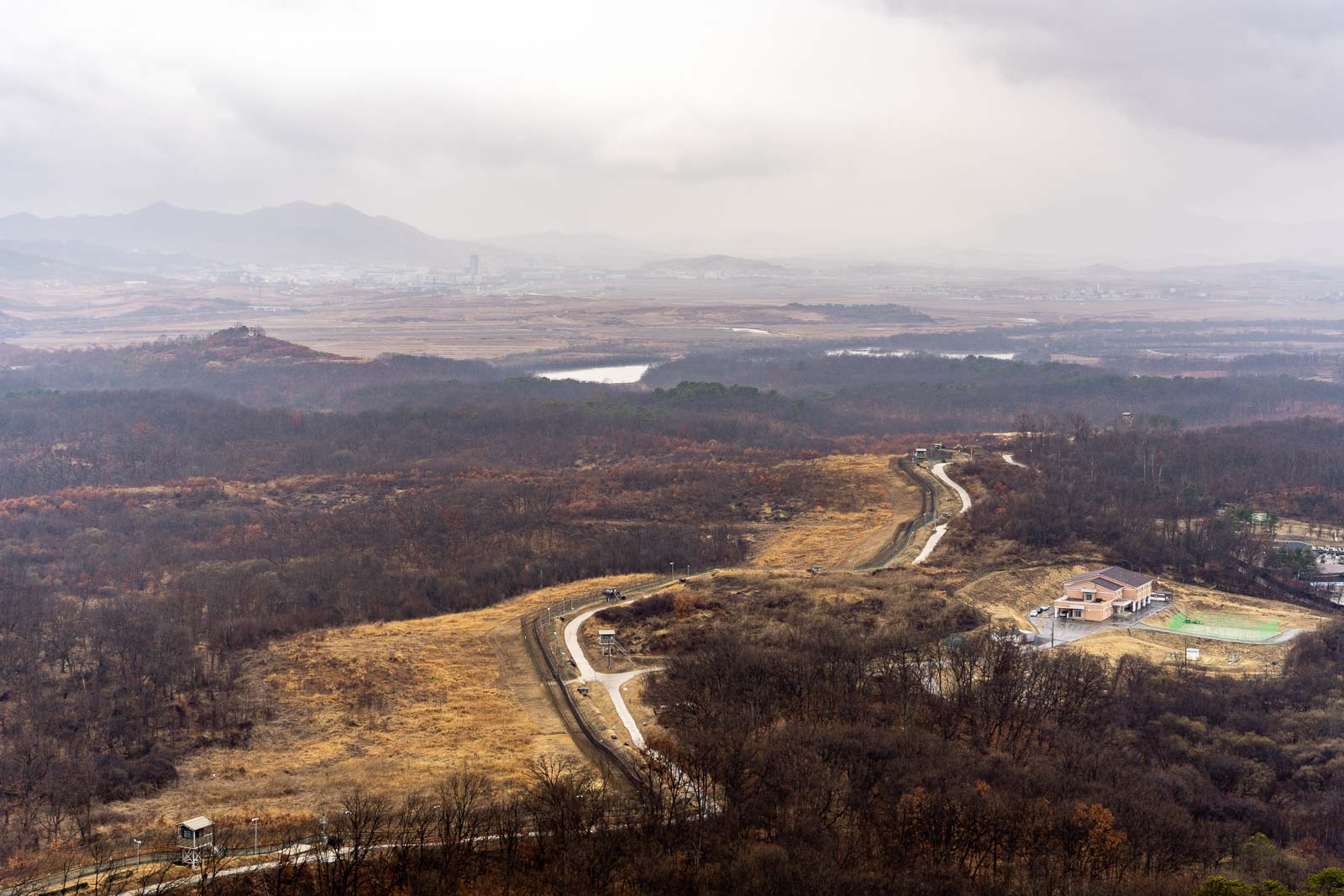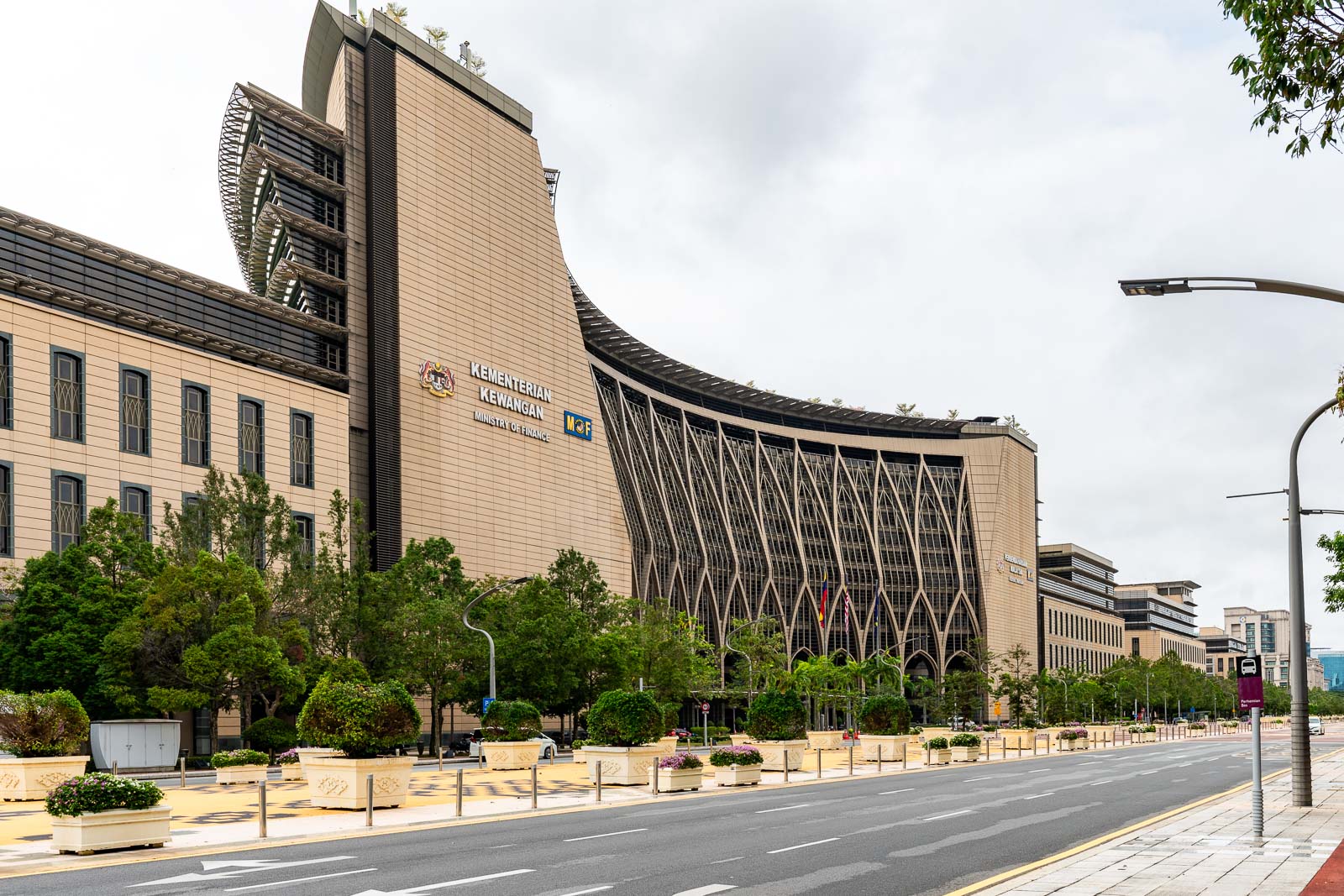This World Heritage town is small but it's packed full of incredible history. The post Things to do in Trogir appeared first on Time Travel Turtle.
From this part of the Croatian coast, the islands beckon.
Thereís the large island of Hvar, with its charming towns and ancient Stari Grad Plain; and thereís also a plethora of smaller ones easily accessible from Split, with gorgeous beaches and welcoming landscapes.
But thereís only one island here that is covered entirely by a historic town, a town so significant that it has been designated as a World Heritage Site.
Iím talking about Trogir: the best preserved medieval town on the east coast of the Adriatic!
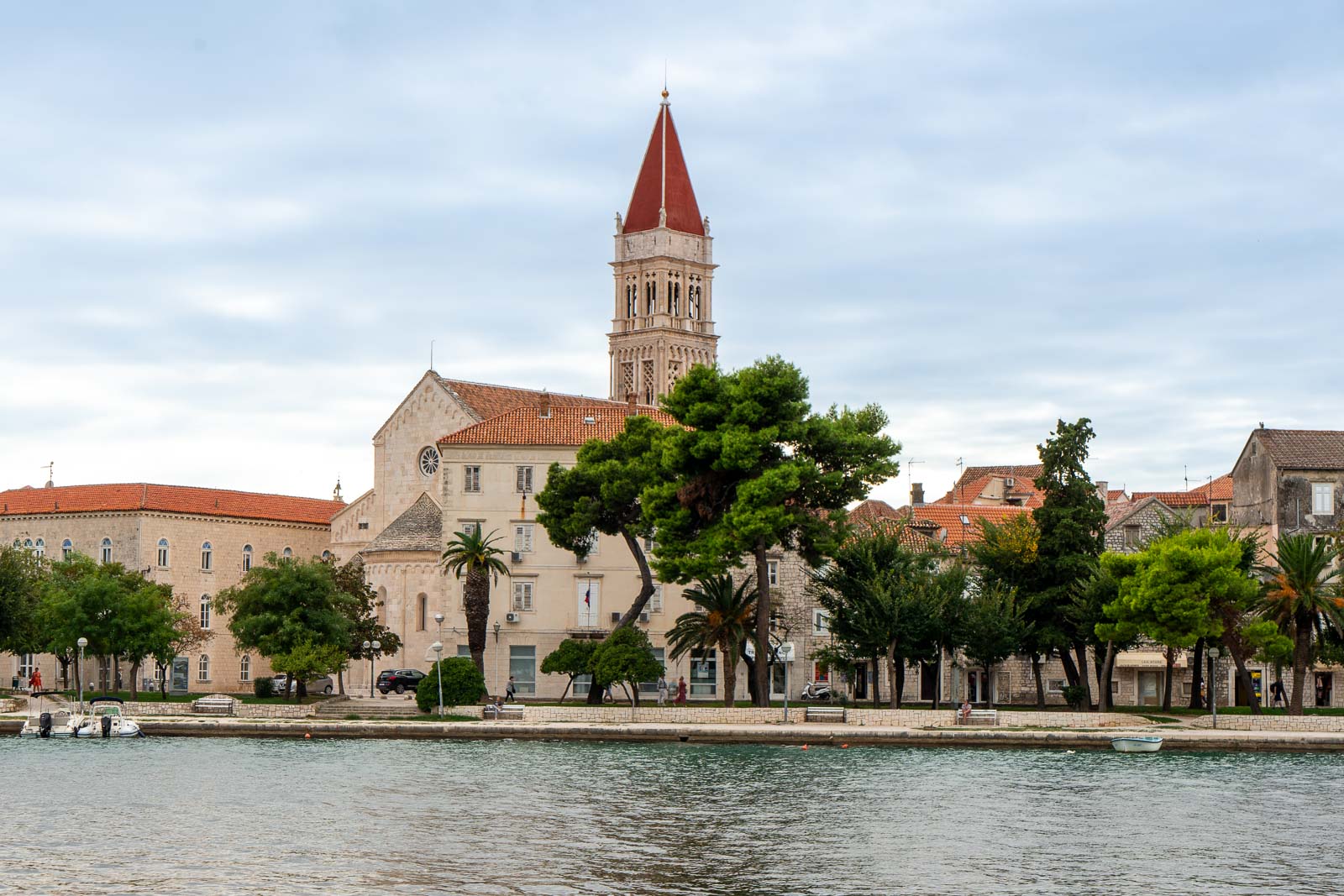
The historic part of Trogir that covers the island is small Ė just 500 metres long and about 200 metres wide. But donít let its size fool you.
The cultural and economic significance of Trogir vastly outweighs its tiny space. Over the millennia that itís been here, itís been one of the most important Adriatic towns, influencing the history of the region.
A brief history of Trogir
It all started in the 3rd century BC when Greek colonists settled here, founding a city that they called Tragurion (which means Ďisland of goatsí).
They laid out the urban plan in a grid pattern surrounded by megalithic walls shaped like an oval.
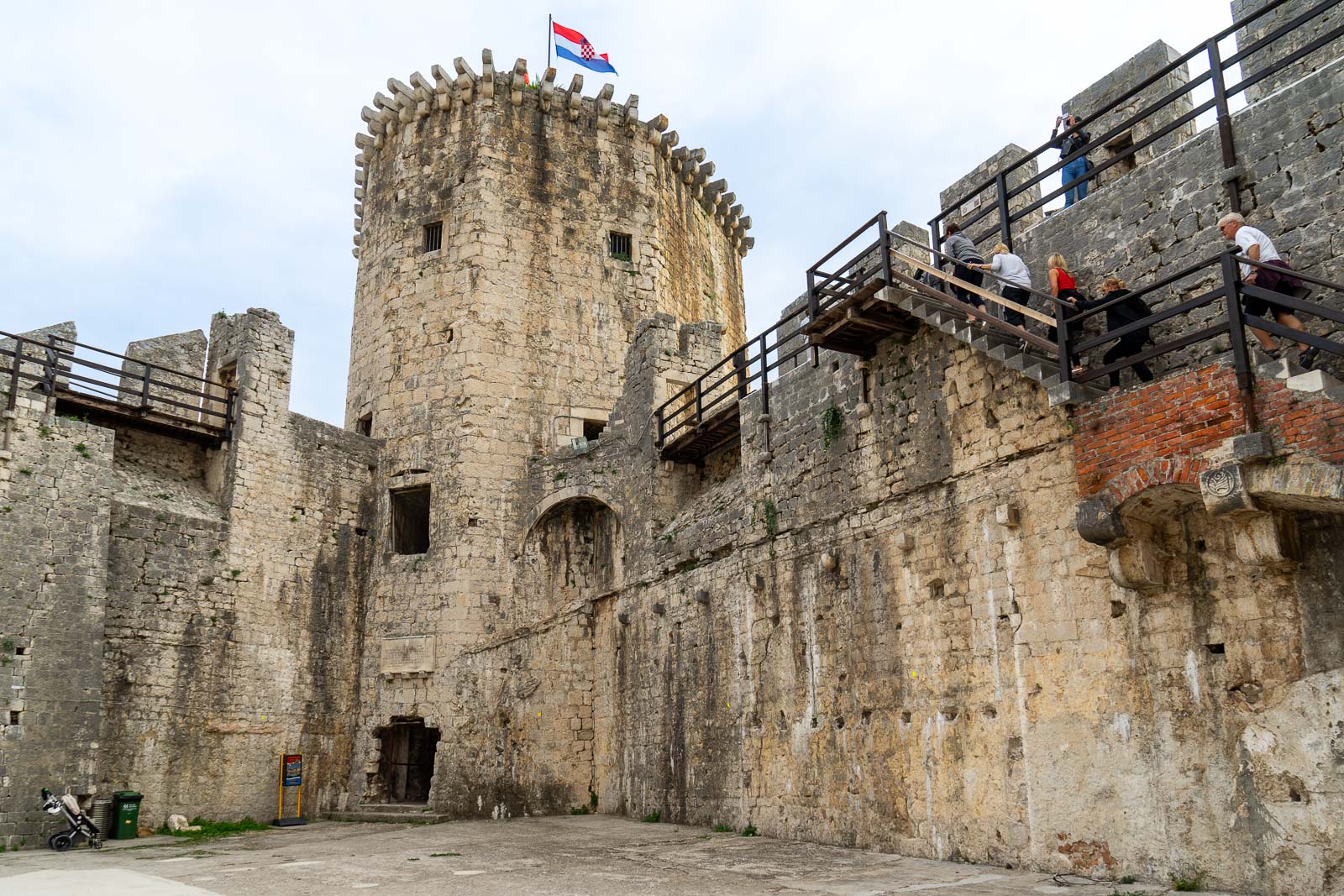
The Romans came next, and the town flourished during that period, eventually being extended and refortified in the Late Roman Era. Two large basilicas were built Ė on the sites that now hold the cathedral and the Church of St John the Baptist.
Over the centuries, Trogir passed hands (as cities in this part of the world are wont to do), from the Byzantines to the Venetians, then the Hungarians, back to the Venetians, then the Austro-Hungarians.
Over this time, successive rulers did significant remodelling, and you can see the renaissance designs in the main town square, and the baroque elements in the fortifications.
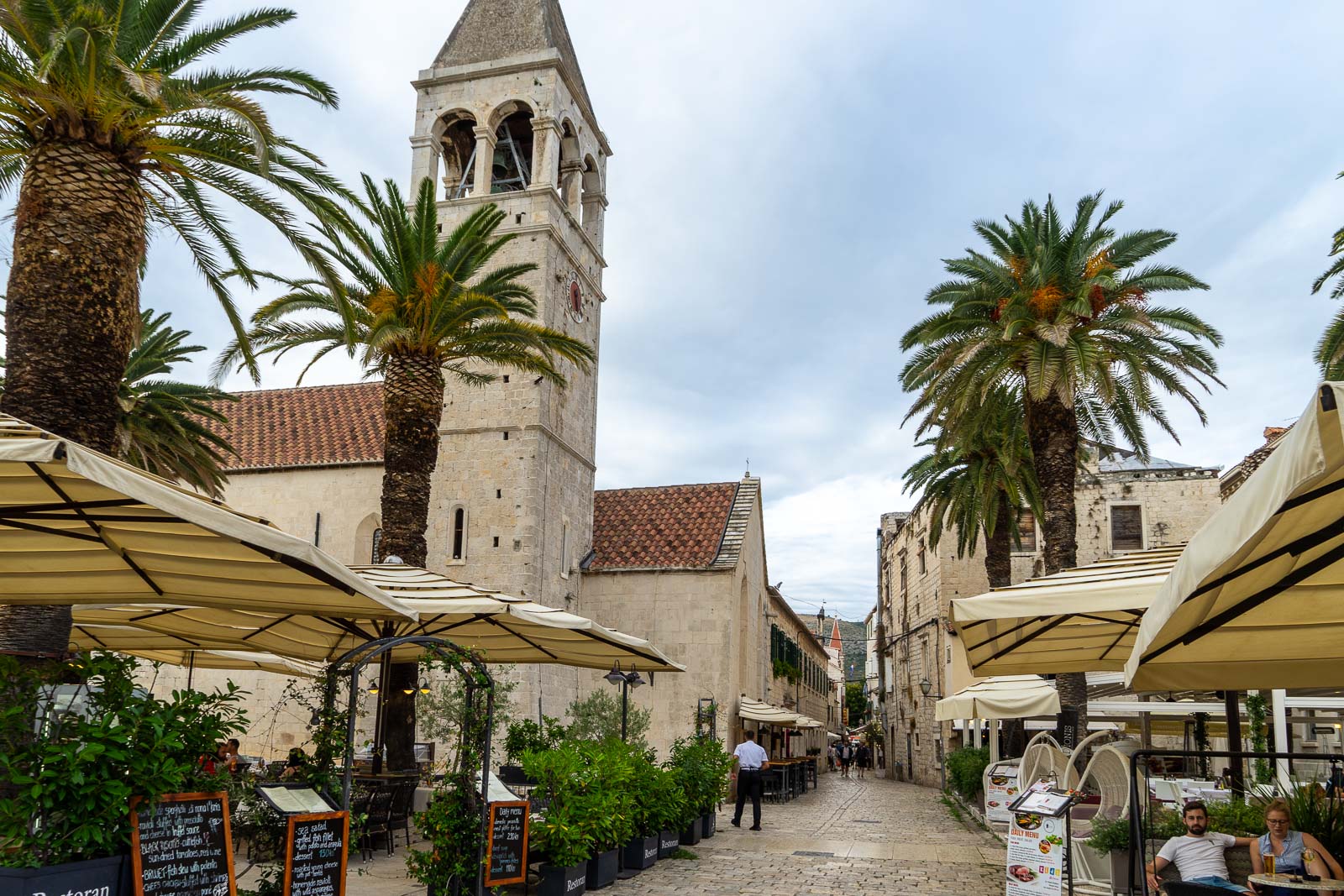
Itís the blend of all of these styles, these little vignettes of the historical record, that make visiting Trogir so special today.
Visiting Trogir
It doesnít take me long to walk from one end of Trogir to the other.
What takes longer is winding my way through the criss-cross of streets in the townís grid.
And what takes even longer than that is stopping to look at all the attractions in Trogir, so many pieces of heritage densely packed into this small island.
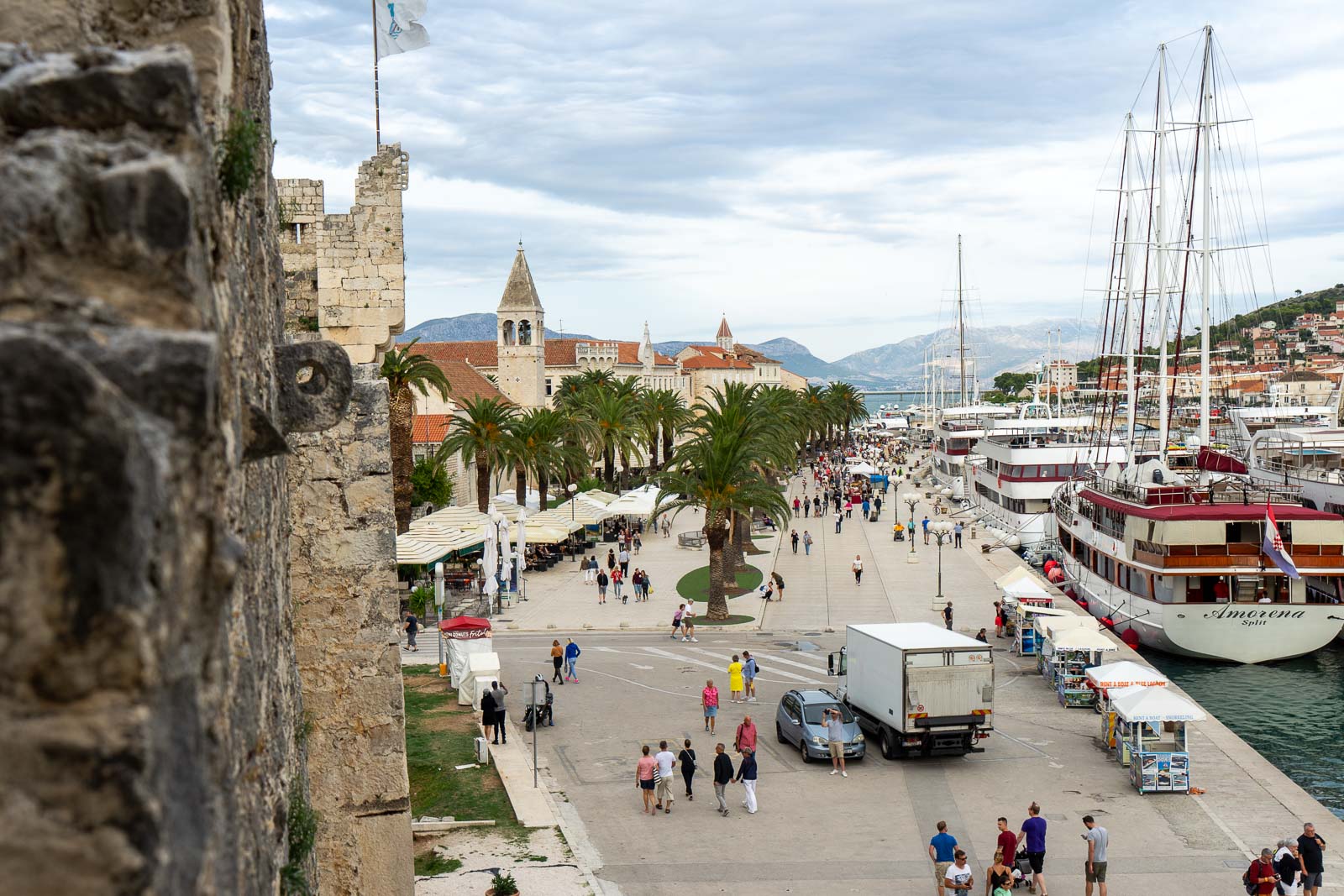
From the walls of Kamerlengo Castle, you can look out to see the perfectly balanced relationship of stylistic formations, all those historic eras playing their part in the overall vista.
But up close, on the streets, there are so many individual masterpieces Ė in the architecture but also in the art.
There are examples of sculpture from many periods of history here, but one of the highlights is the portal of the Cathedral by Radovan, from 1240.
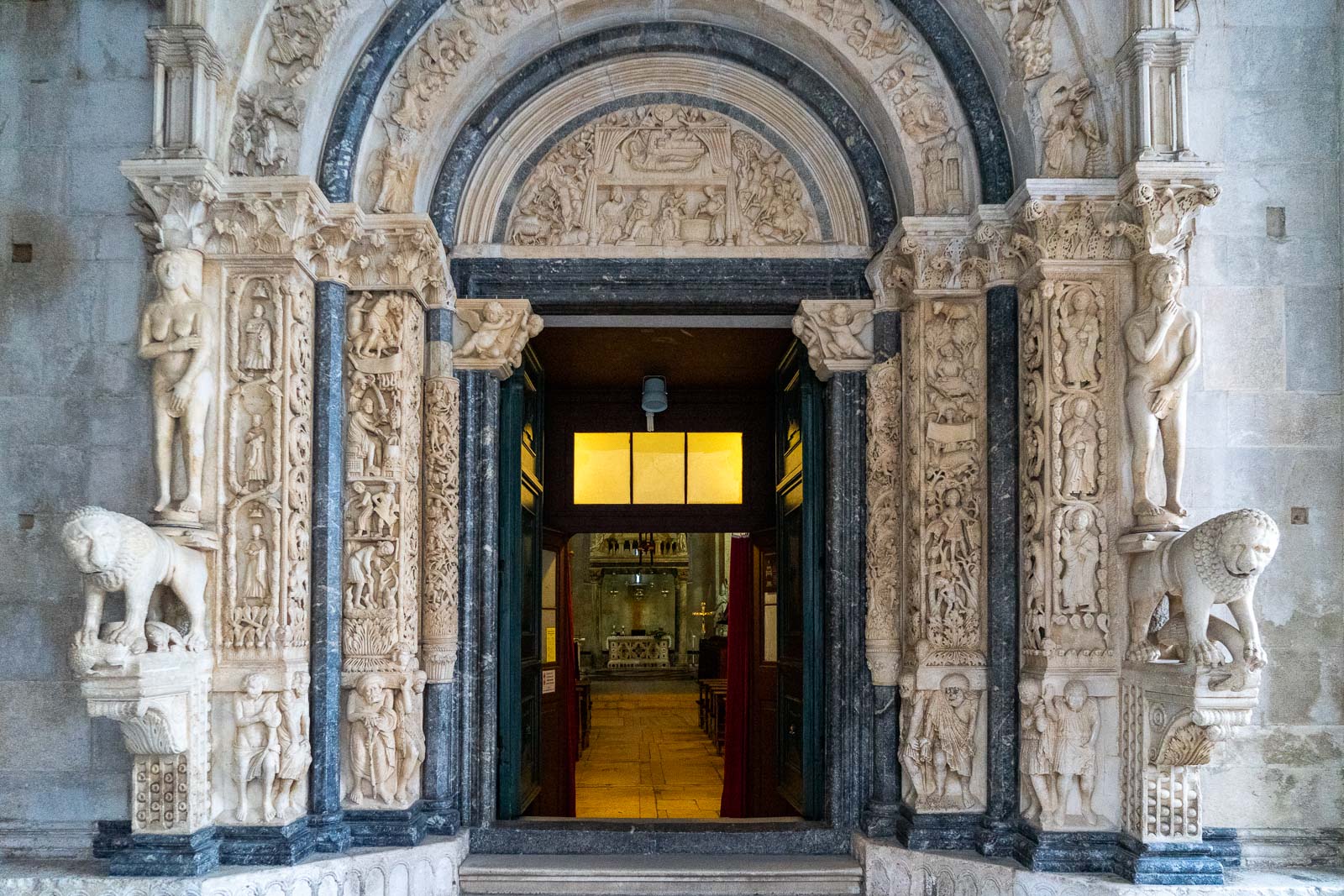
The longer you spend here, the more youíll find, particularly inside the historic centreís many churches.
To make sure you donít miss these details, I would recommend this very good walking tour of Trogir.
Of course, the city of Trogir these days includes the modern part on the mainland. But, to be honest, thereís not too much there that is of interest for visitors.
Most of the things to do in Trogir are on the island or on the outskirts of the city.
Itís why most people visit Trogir as a day trip from Split, rather than base themselves here. But itís actually not such a bad place to stay because youíre away from the craziness of the big city.
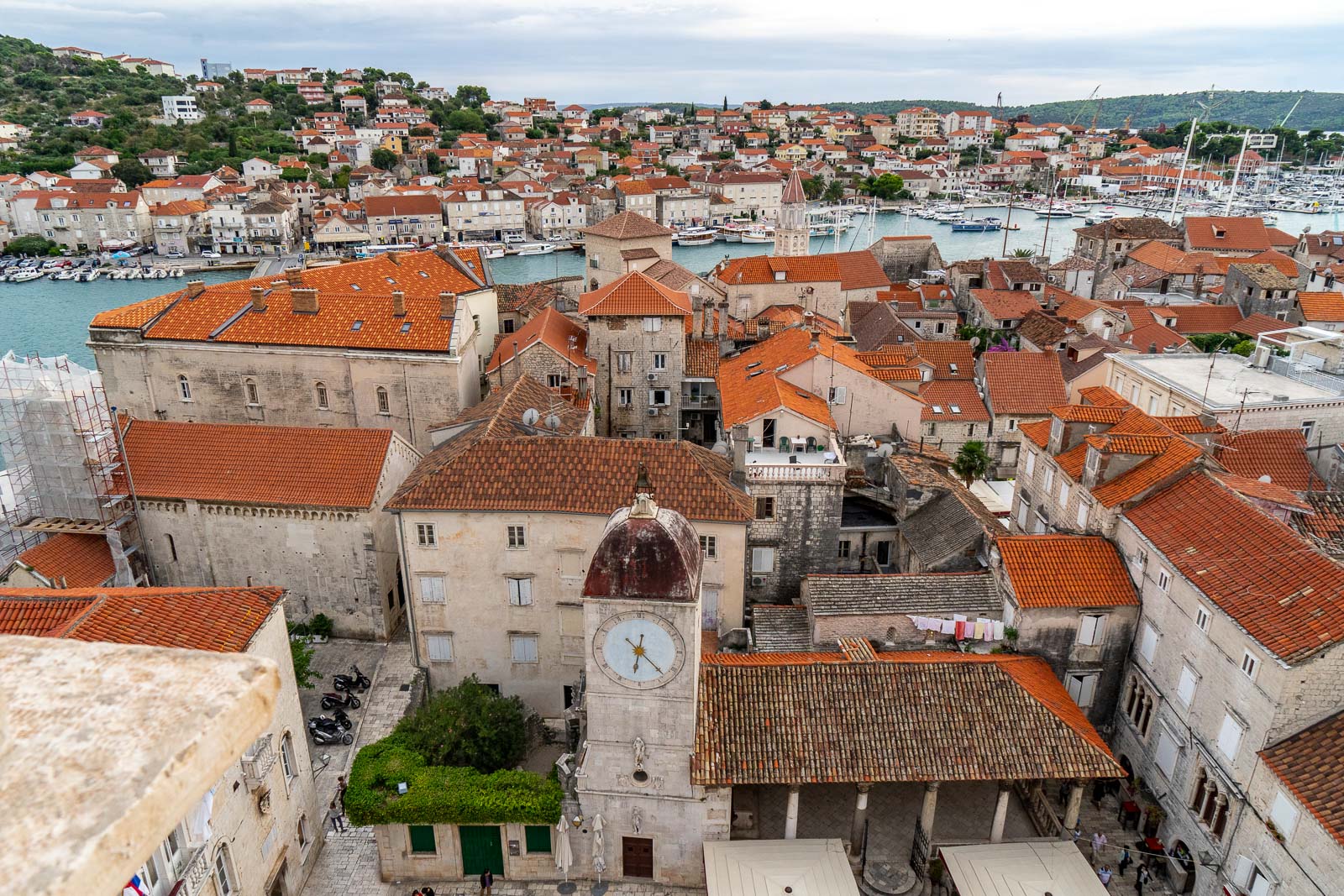
Still, you wonít need more than a day to explore the sights of Trogir, so letís have a look at what youíll find here.
Main square
Trogirís main square is a fantastic place to start your visit, where winding medieval alleyways filter into a central meeting place for locals and visitors alike.
Although the whole town is fairly walkable and youíll find many of the top things to do in Trogir just by wandering, some of the most important are here in the square, including the stunning cathedral, town hall, loggia and clock tower.
This is also where youíll find the Cipiko Palace. Even though the 15th-century palace is not open to the public, from the outside you can admire its beautifully decorated Gothic-style windows.
At night the square fills with Croatian folk music and is the perfect place to have a beer, coffee, or gelato at the local bars and cafes.
Cathedral of St Lawrence
The Cathedral of St Lawrence is one of the top attractions in Trogir and a must-visit. The Roman Catholic basilica began life in the 13th century, but construction of the cathedral was slow going and took several centuries to complete. This means itís a mix of styles with influences ranging from Romanesque to Gothic architecture.
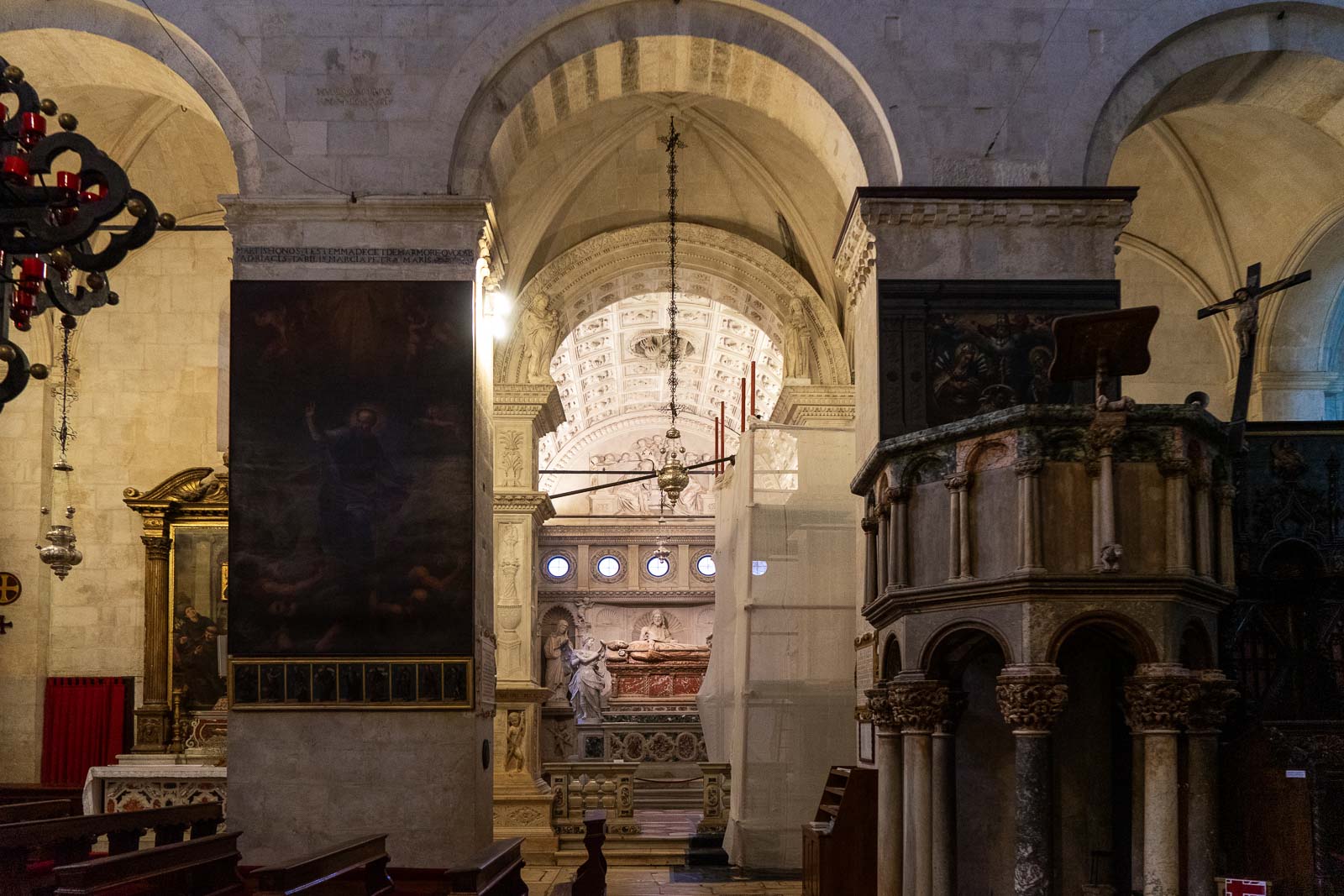
Look out for the striking Radovanís Portal, the elaborately sculpted entrance named after the 13th-century Croatian Master Radovan.
Another sight not to miss is the cathedralís Bell Tower. As the tallest structure in Trogir, itís well worth the Ä3.50 entry fee to climb up and take in the outstanding views of the city.
City Hall
The 14th-century City Hall can also be found in the main square, right in the heart of the historic city. Its grandeur gives you a sense of the political and economic strength the Trogir once wielded.
Itís well worth a quick look inside as you will find a peaceful courtyard with a monumental Gothic staircase.
Another reason to visit is that it is home to Trogirís Tourist Information Centre. Pop in and chat with an expert about the best sights around town Ė no one knows the city like the locals.
City Loggia
Next up is the 15th-century City Loggia. With both Gothic and Venetian architecture the building is a testament to the many merging histories of this diverse city.
The Loggia was once central to the politics and social events of the town. Nowadays it houses artworks from the Renaissance including works by Nikola Firentinac, as well as more modern pieces.
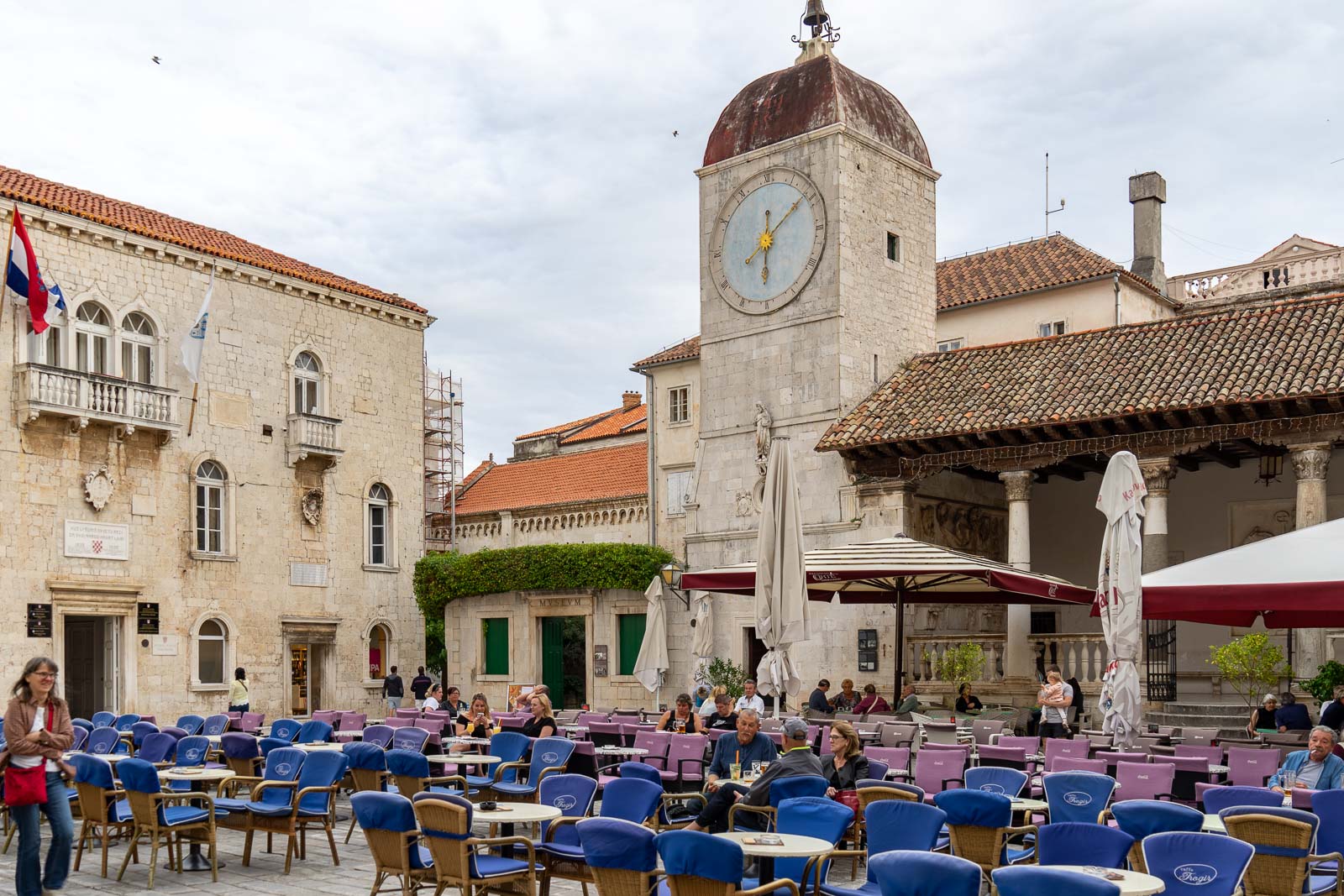
Make sure to spot the stone carvings in the small archway at the entrance. The arches and columns are intricately adorned with interesting carvings.
You can also visit the Clock Tower, one of the icons of the city, which is situated right next to the City Loggia.
Waterfront
Alongside the old town is Trogirís clean and well-kept waterfront. Full of trendy cafes and bars, itís one of the best places to hang out in the city.
You might recognise parts of it from Game of Thrones, in which it was used as the city of Qarth in season 2. But itís best known as the place to go if you want to find a boat to one of Croatiaís many islands.
Promenade
The palm-lined promenade is busy both day and night. You can find a range of great restaurants as well as day trips to some of Croatiaís best sights.
The wide paved walkway is the perfect place to take a gentle stroll and take in the atmosphere of this laid-back city. Spot sailboats and imagine the lives of the people on the expensive yachts docked out on the water, or find your own adventure by renting a boat for the day.
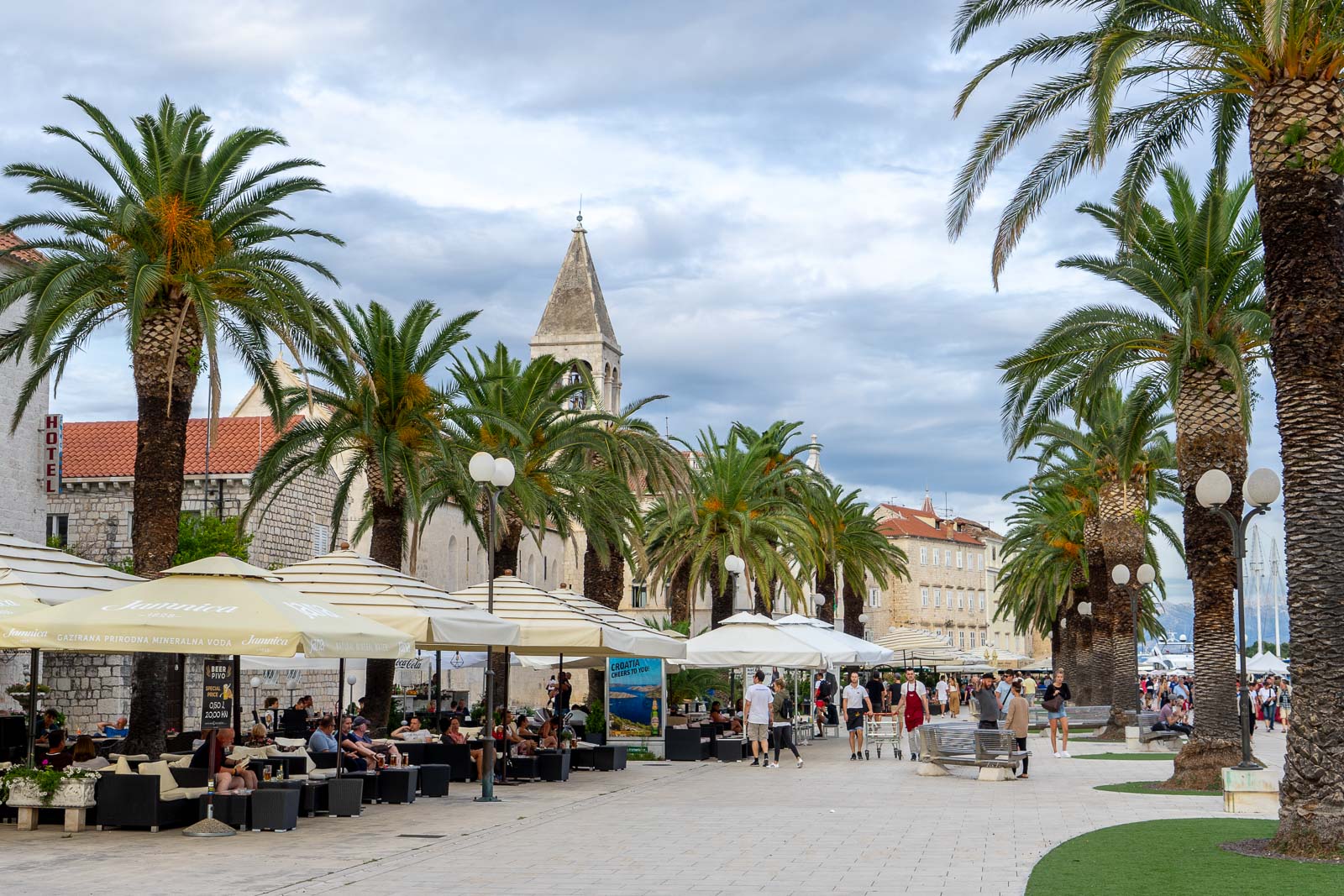
Whatever you spend your time here doing, be sure to make the most of the ample gelato stands!
Kamerlengo Castle
Out on the south-west corner of Trogir Island is Kamerlengo Castle, also known as Kamerlengo Fortress.
Along with the now demolished city walls, Kamerlengo was part of the cityís impenetrable defence system during the Venetian rule from the 15th to the 18th century.
It was built by the Venetians in the 1400s, right after the triumphant conquest of Constantinople, in order to protect the city from invaders and pirates.
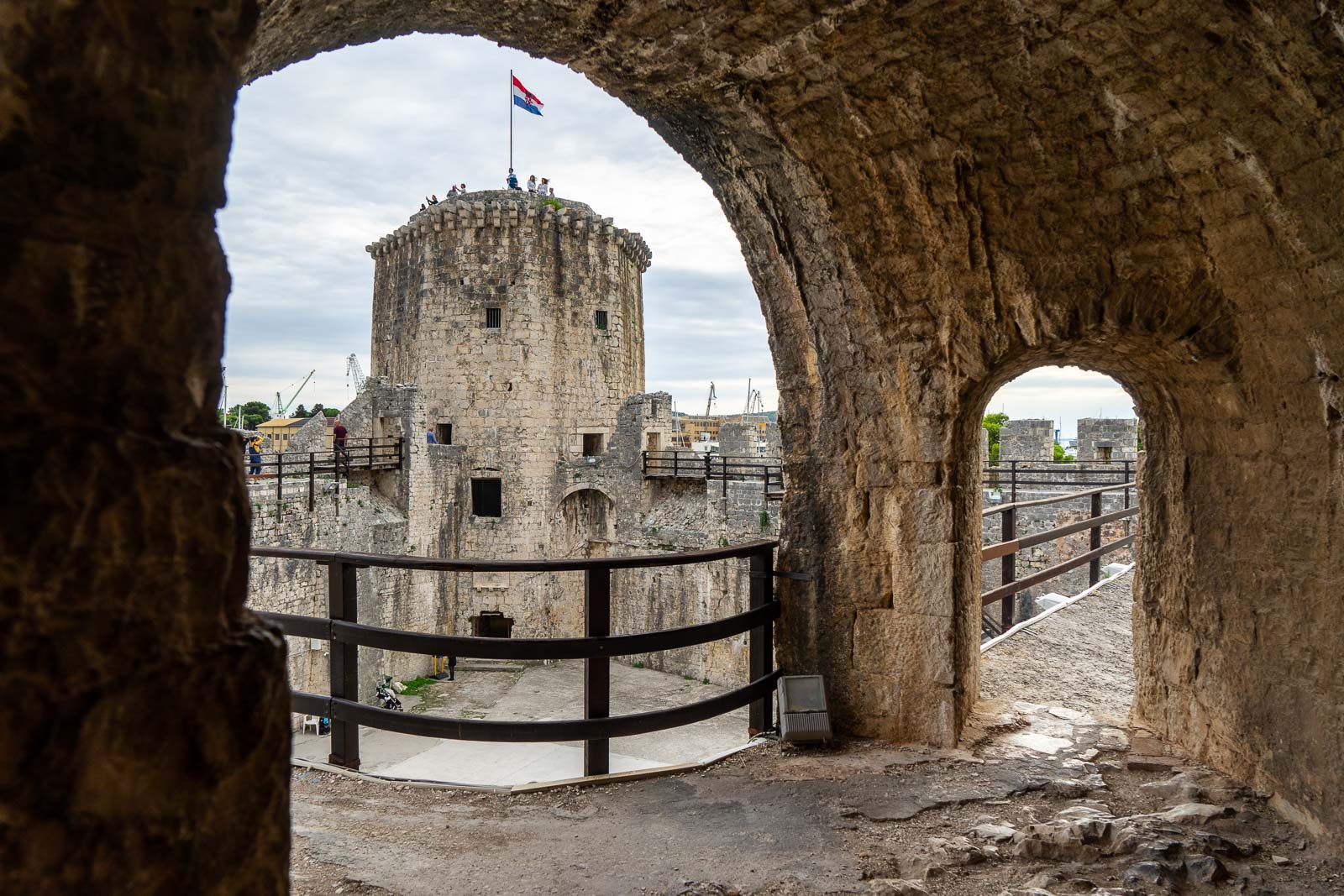
Although there is not much to see inside the castle itself, from St Markís Fortress you can get a panoramic view of Trogirís medieval historic centre Ė well worth the entry fee.
Kamerlengo Castle is only open during the summer, when you might even be lucky enough to catch one of its regular outdoor performances or open-air cinema screenings.
South City Gate
The South City Gate (also known as Juěna gradska vrata, South Marine or Sea Gate) forms part of the islandís original defences as one of Trogirís old city gates.
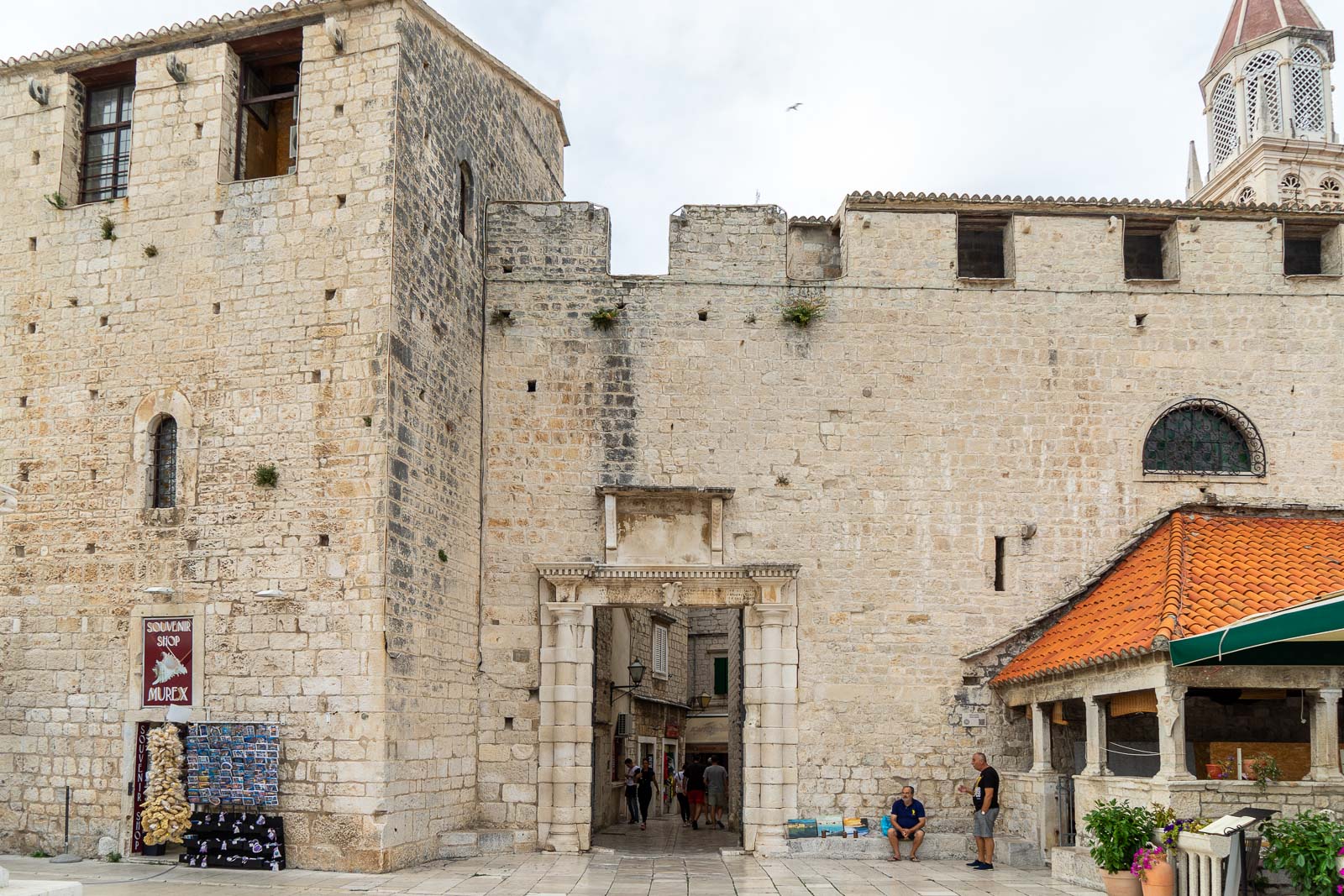
But the first gate you will come across when entering the city is the North Gate (Sjeverna gradska vrata) at the end of the small bridge that you have to cross to access the island. Constructed in the 1600s, itís one of the most ornate historic monuments in Trogir.
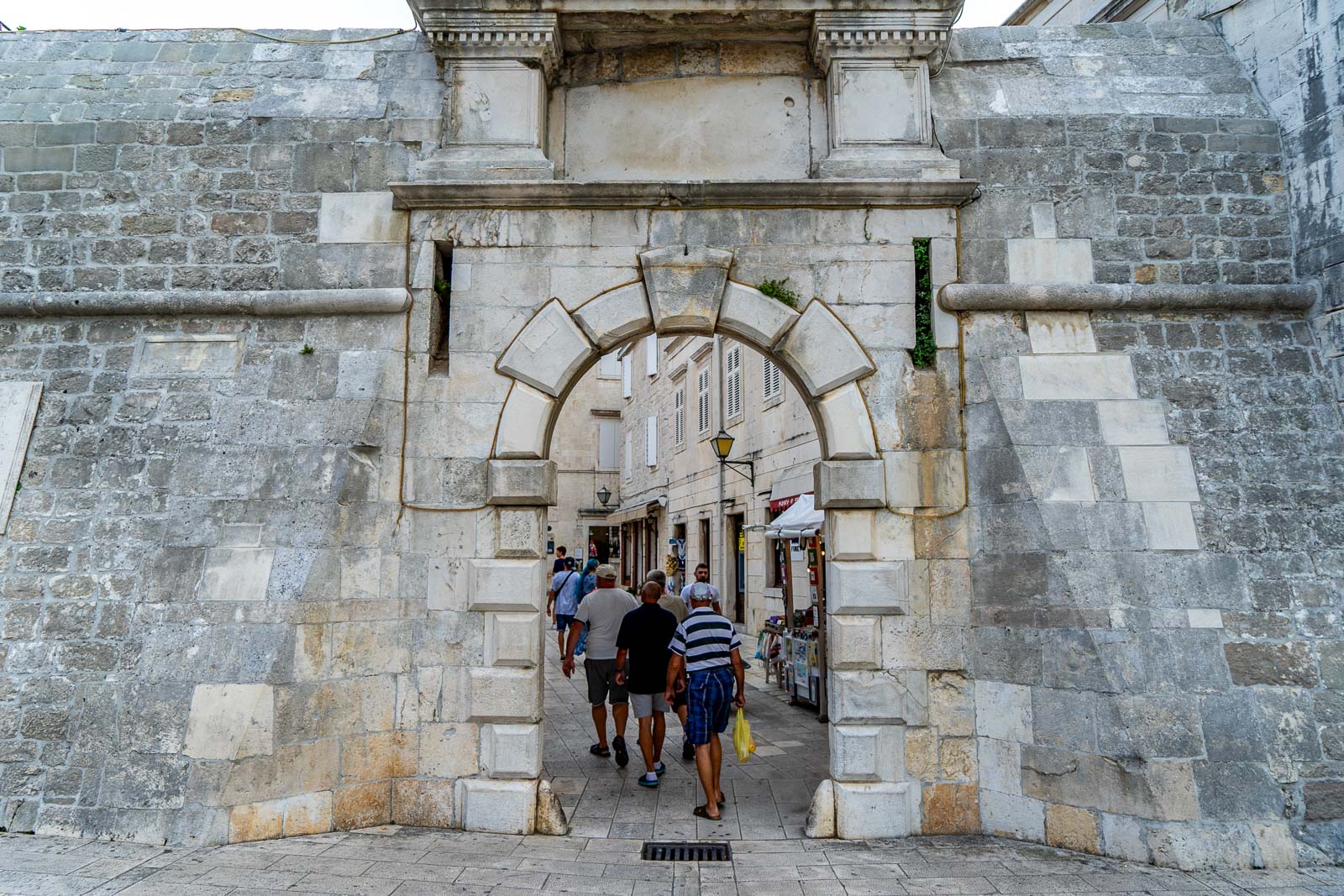
All around the old city, you will find parks and gardens like the German Ruěi?njak Rosengarten, with stunning views over the old and new city.
Churches
The medieval town of Trogir is packed with religious architecture Ė in fact, you have to wonder how they fit so many churches into such a small area!
From the opulence of the Cathedral of St Lawrence to the austere ancient monastic complex of the Dominican Order, the collection of Romanesque churches and Benedictine monasteries should make your list of places to visit in Trogir.
Benedictine Monastery of St Nicholas
This historic monastery has stood in Trogir for just under a thousand years and holds some beautiful artworks. The female Benedictine monastery was founded in 1064 after St John of Trogir and has housed nuns ever since. Holy Mass is still celebrated every day at 6 oíclock in the evening.
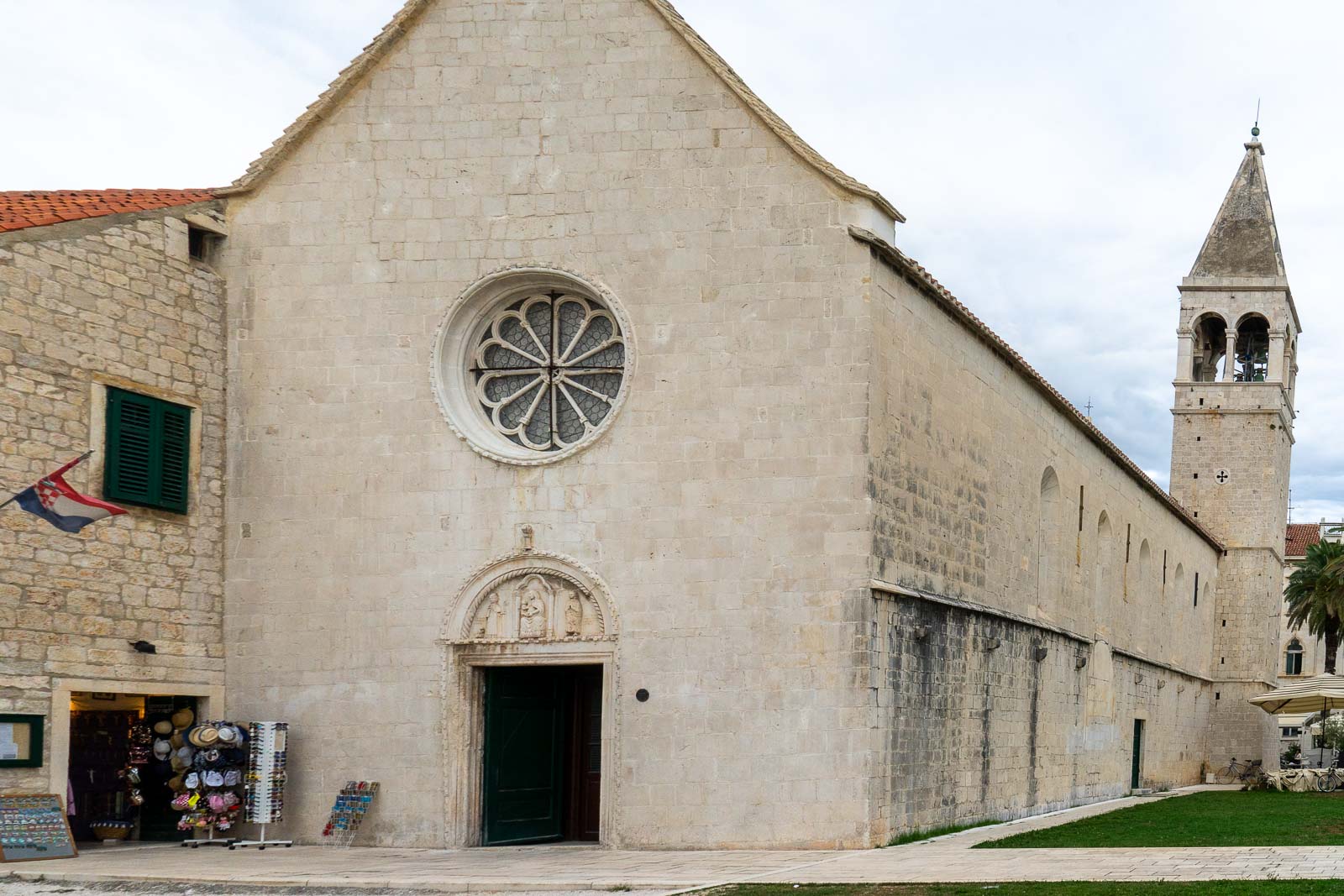
Itís located along the city walls in the southeastern part of Trogir. Though only three Benedictine sisters live inside today, the way of life remains somewhat a mystery due to the sacred vows of this order. However, visitors are allowed to enter the courtyard for free or pay a small fee to enter the museum.
Highlights of the Benedictine Monastery of St Nicholas include the oldest relief in Trogir (3rd century BC) which shows the Greek god of happiness, Kairos the youngest son of Zeus, as well as reliefs of other Greek gods like Achilles.
Church of St Peter
Dedicated to the patron St Peter the Apostle, this small church is worth a stop while strolling around in the old town.
The sculpture at the entrance shows Peter looking down on visitors, holding a Bible and scrolls from the 15th century. Inside there are artworks by historically important artists such as Molinari and Lazzarini, as well as more statues of St Peter and St Paul.
Other churches
The Chapel of St Sebastian is no longer a working religious building but is still well worth a visit. Constructed in 1476, the church features a large blue-faced Renaissance clock that makes it really stand out amongst the other buildings of Trogir.
Inside you will find curious stone sarcophagi and the photos of locals killed in the 1990s war. It serves as a memorial to those who lost their lives and is an interesting place to learn a bit about recent local history.
Other interesting churches to visit are the Church of St Dominic with its slender bell tower and austere monastery, and the Catholic Church of Our Lady of Mount Carmel.
Museums
There are lots of museums to visit in Trogir too, perfect for a rainy day or as a way to learn a bit more about the cityís history. Thereís even an opportunity to get wet while experiencing some of Trogirís cultural highlights at the Via Crucis Underwater Museum.
City Museum
The Trogir City Museum (Muzej grada Trogira) is located near the northern entrance to the island, housed in the former Garagnin-Fanfogna palace.
Itís a great introduction to the city with period furniture and costumes, famous portraits, and interesting exhibits on the cityís unique history. The City Museum can be seen in around 30 minutes and costs just Ä4 euros per person to enter (cash only).
From the courtyard, you will also find the gallery of Trogir-born Cate Dujöin Ribar, best known for painting stunning Dalmatian landscapes.
Museum of Sacred Art
Another small museum to visit is the Museum of Sacred Art just off of Trg Ivana Pavla II on the first floor of the Parish Court. It displays paintings from the 13th to the 16th centuries, some originally from the Cathedral of St Lawrence and some from other churches in Trogir.
There are several illuminated manuscripts including a large painting of St Jerome and St John the Baptist by Bellini. Another shows a brightly painted Crucifix holding Christ, whilst another darkly lit piece holds fragments of a 13th-century icon that once adorned the Cathedralís altar.
Via Crucis Underwater Museum
Located in Jelinak Bay, near the historic city of Trogir, you will find the Via Crucis Underwater Museum. Just beneath the waves lie 50 life-size statues and an impressive 8-metre tall statue of Jesus Christ.
As most of the site is only 4 or 5 metres deep itís easy to snorkel and is a fun day out for the whole family. If you want to go diving you can get even closer to the museum and get a better look at the large statue of Jesus set at a depth of 12 metres below sea level.
Outside the historic centre
Itís not just the historic centre that offers fun things to do in Trogir. Leave the medieval winding streets and ancient history behind as you explore the modern city and beautiful beaches that line this part of Croatiaís coast.
Market
On the mainland, just before you get to the bridge to the old town, you will find Trogir Market. Thereís the Green or Farmers Market thatís full of fresh local produce as well as wines and olive oils, and the souvenir and clothing stalls that you would usually expect to find.
Expect to negotiate with prices, and get to know the locals better by bartering and learning more about their crafts and produce. Unlike many other markets, Trogir Market remains open all day so itís a great place to head for a late lunch or early dinner.
Beaches
One of the closest beaches to Trogir is the serene Medena Beach, located around 4 km from the city centre. The gravel beach has enough room for everyone at around 3 kilometres long.
Itís a popular spot for locals and families as well as tourists because of its crystal clear waters that are calm enough for safe swimming in the Adriatic Sea.
Another one of the best beaches near Trogir is Okrug Gornji Beach, located on the island of ?iovo. Itís known as ĎCopacabanaí because of its golden sand, as well as a good selection of cafe-bars and restaurants and a range of water sports. It can easily be reached by car or water taxi from the main town.
?iovo
For an easy day out from Trogir, take the regular boat from Trogirís main waterfront to the island of ?iovo. Boats depart every 30 minutes throughout the summer, but the island is also connected to Trogir via a road bridge.
Okrug itself is a traditional Dalmatian village with a rural community. The island is best known for its beaches like Labadusa Beach, Kava Beach, and Okrug Gornji Beach, but the village is well worth a look around too.
It was founded around the 15th century as a fishing village and is one of the oldest settlements on the island.
Tours
One of the best ways to experience Trogir is to join a local guide for a tour of the city or the surrounding area. Book a tour early on your visit here and you will find out all sorts of interesting local tips and insider knowledge on where to eat, and what to visit in Trogir City.
City tour
Where better to learn about the history of Croatia than in one of the oldest towns on the Adriatic coast? Founded in the 3rd century BC, Trogir is full of historic UNESCO World Heritage monuments; itís an open-air museum.
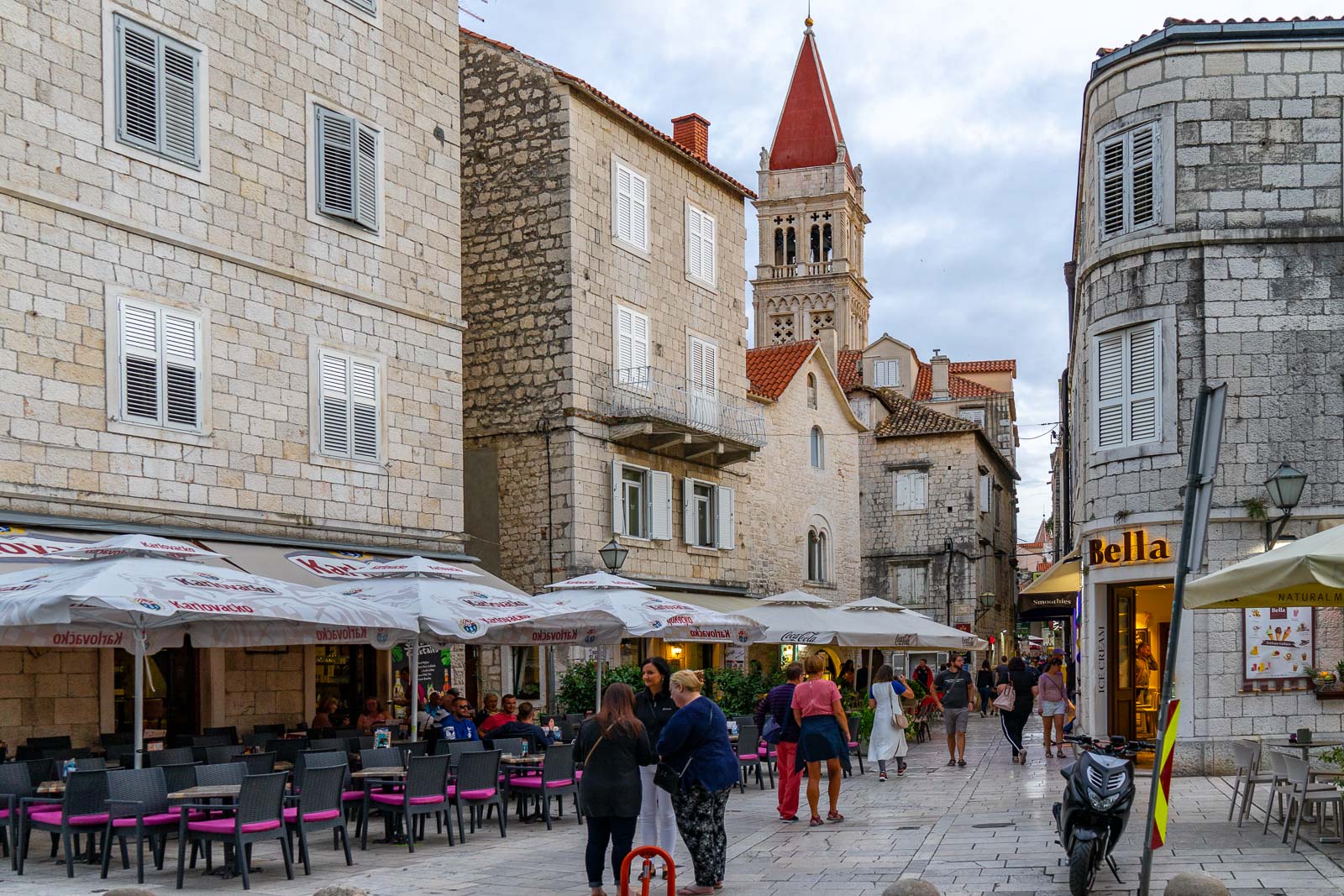
Discovery Tours offers a 1.5-hour guided walking tour of Trogir Old Town starting from the main gate, Sjeverna gradska vrata. The local guide will lead you through the narrow streets, uncovering the interesting history and little-known facts about the area. Prices start from Ä20 per person.
Night tour
Another great option to see the city in another light is to take a nocturnal tour of Trogir. Find out about the myths and legends of old Trogir on an after-dark walking tour of the city.
The Myths and Legends of Old Trogir Tour is one of the best ways to uncover secrets of the cityís past. This small group night tour of Trogir leads you through the 2,300-year-old streets by lantern light for a truly atmospheric experience. The one-hour walk starts from Ä24 per person and has a maximum of 8 travellers.
Boat to the islands
There are so many beautiful islands just a stoneís throw away from Trogir, it would be a shame not to visit a few of them. Take a half-day boat trip from Split to explore the Croatian coast a little better.
I would recommend this speedboat tour from Split, which offers a swim and snorkel stop in the Blue Lagoon. Spend the day at Laganini Beach Club on ?iovo Island where you will find fine white sand, chic beach bars and shady pine trees before taking a boat ride to Blue Lagoon.
Day trips
Once youíve got to know the city, why not use Trogir as a base to see some other sights around Croatia, either nearby or a bit further afield.
There are some great day trips from Trogir that you can do independently or with one of the local tour operators.
Split
Just 30 minutes drive away, itís likely you will pass through Split at some point during your trip to Trogir. But this incredible city deserves at least a whole day, so it may make more sense to do it as a side trip.
Some of the best things to do in Split are within the walls of the Palace of Diocletian, the ancient complex built by the Roman Emperor in the 3rd century AD that the modern city has now spilled into.
Within this World Heritage Site, take particular note of St Domnius Cathedral, the Temple of Jupiter, and the Vestibule.
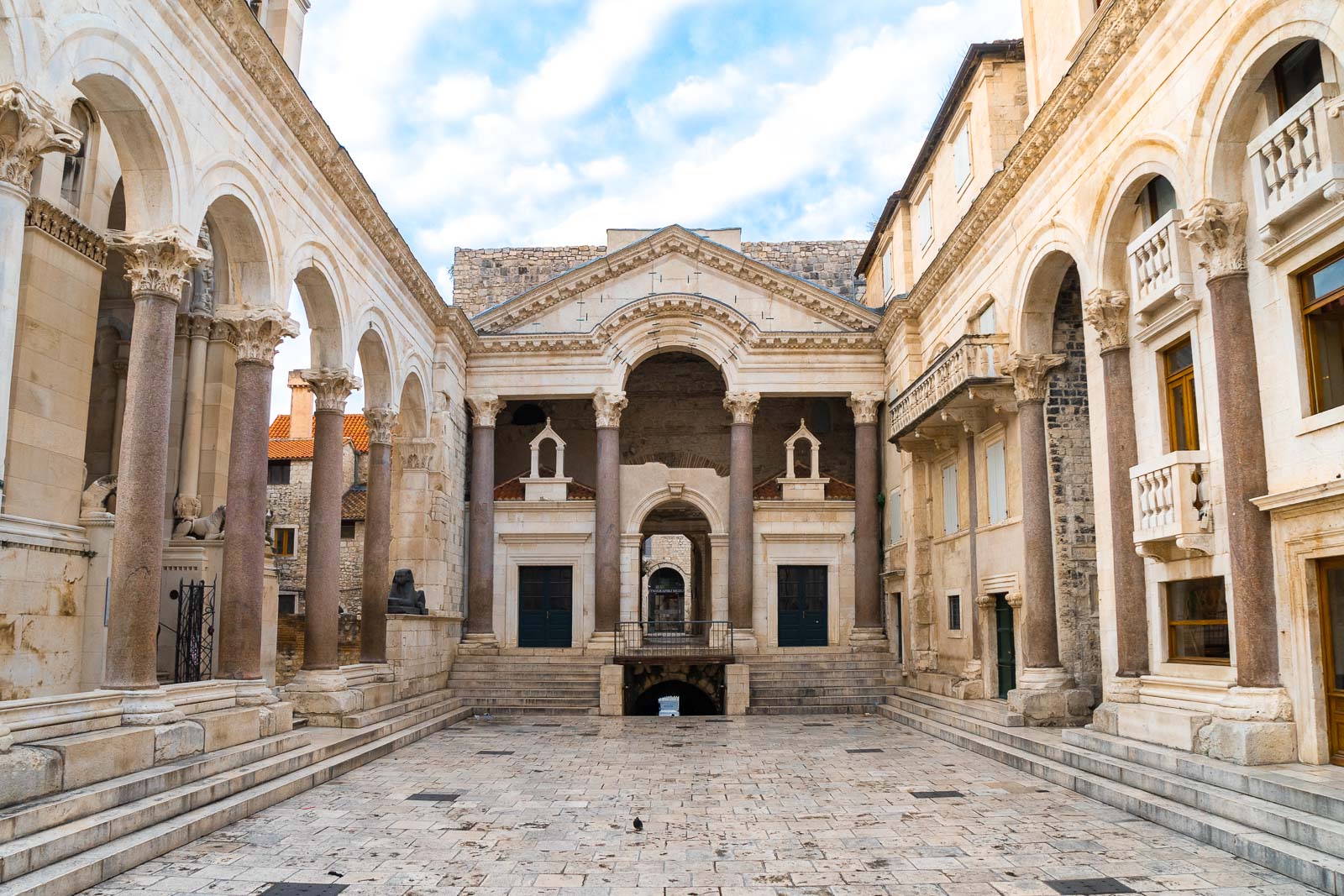
There is this very popular walking tour of the Old Town that I would recommend. Or there are some more good options here:
While in Split, you can also take a walk up Marjan Hill for a wonderful view across the city and the water, visit some of the museums, or just spend time along the water.
Hvar
Although there are lots of islands around Trogir, the most important one is Hvar Ė about 30 kilometres off the coast.
You could easily spend a few days there because itís a destination in itself with gorgeous beaches, quaint towns, and some excellent dining right on the water.
But there are good ferry connections to Hvar, so itís also somewhere you could visit with this full-day tour from Trogir, or as a day trip independently
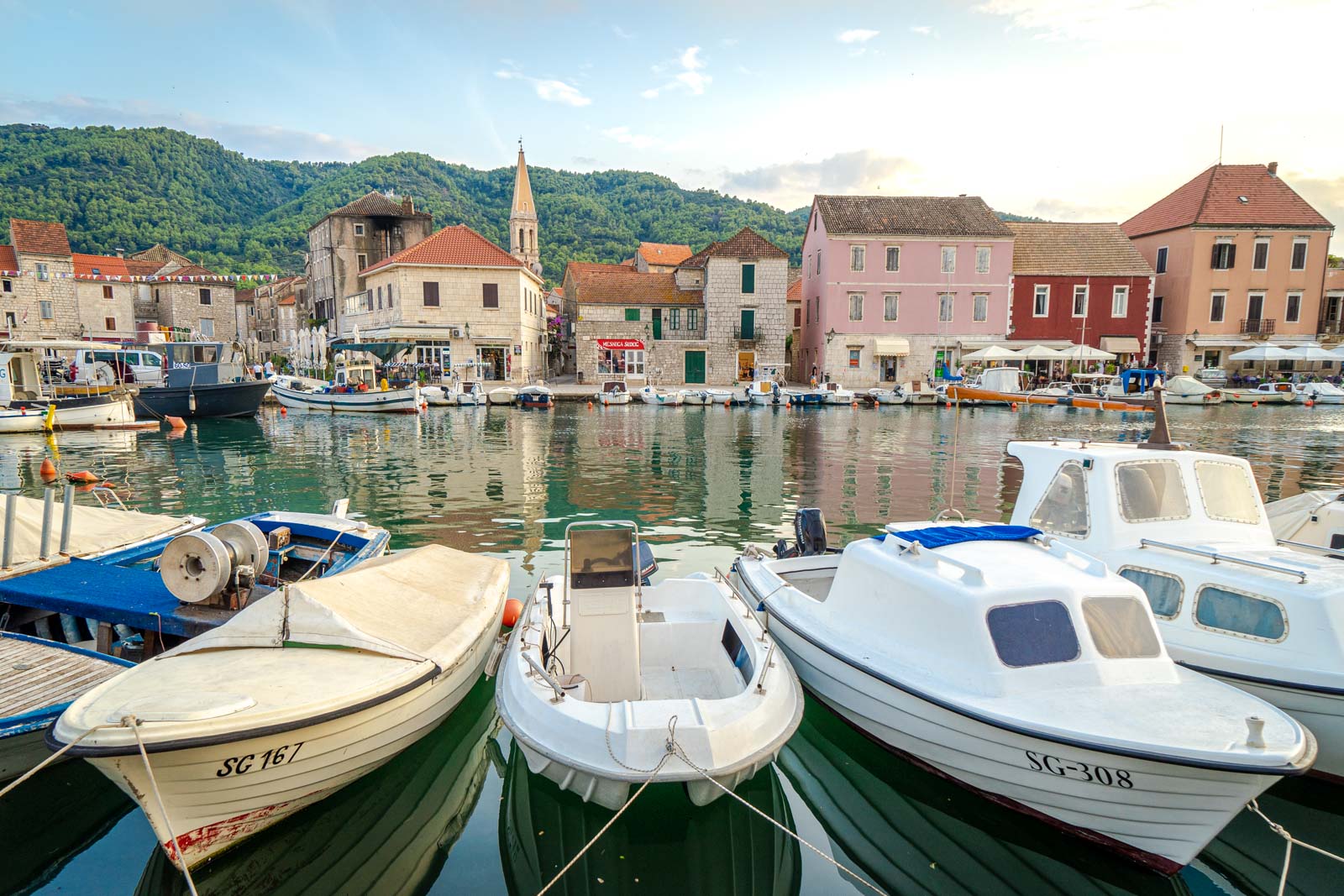
If you do, then there are lots of things to do in Stari Grad, the most historic part of the island Ė including the ancient agricultural plain, which is one of Croatiaís World Heritage Sites.
Krka Waterfalls
Although there are a few things to do in Krka National Park, itís the waterfalls that are the highlight, with tendrils of white flowing down the rocks into a large turquoise pool beneath them.
About an hourís drive from Split, Krka National Park is a large protected area around the main river. If youíve got time to do some hiking along the paths, you may even spot some wildlife. Or just relax at the main waterfalls, known as Skradinski Buk, where you can take a swim.
A boat trip is an excellent way to explore the park, with an old monastery on the tiny island of Visovac. And thereís also Roski Slap, another series of waterfalls with 12 cascades spread along a length of 450 metres.
To get there and make the most of a visit, this great tour from Trogir will take you to all the highlights, or there are some other great options here:
Other cities
And finally, while I wouldnít actually suggest travelling too far for a day trip (why waste the time when thereís so much to see here), the reality is that sometimes you really want to see something and youíre short of time.
Thatís why you can also use your visit to Trogir to visit somewhere else in Croatia (or even Bosnia & Herzegovina).
A popular trip is to Dubrovnik, to see the fortified medieval city set on the water Ė a true pearl of the Adriatic. If thatís of interest, thereís this tour to Dubrovnik from Trogir.
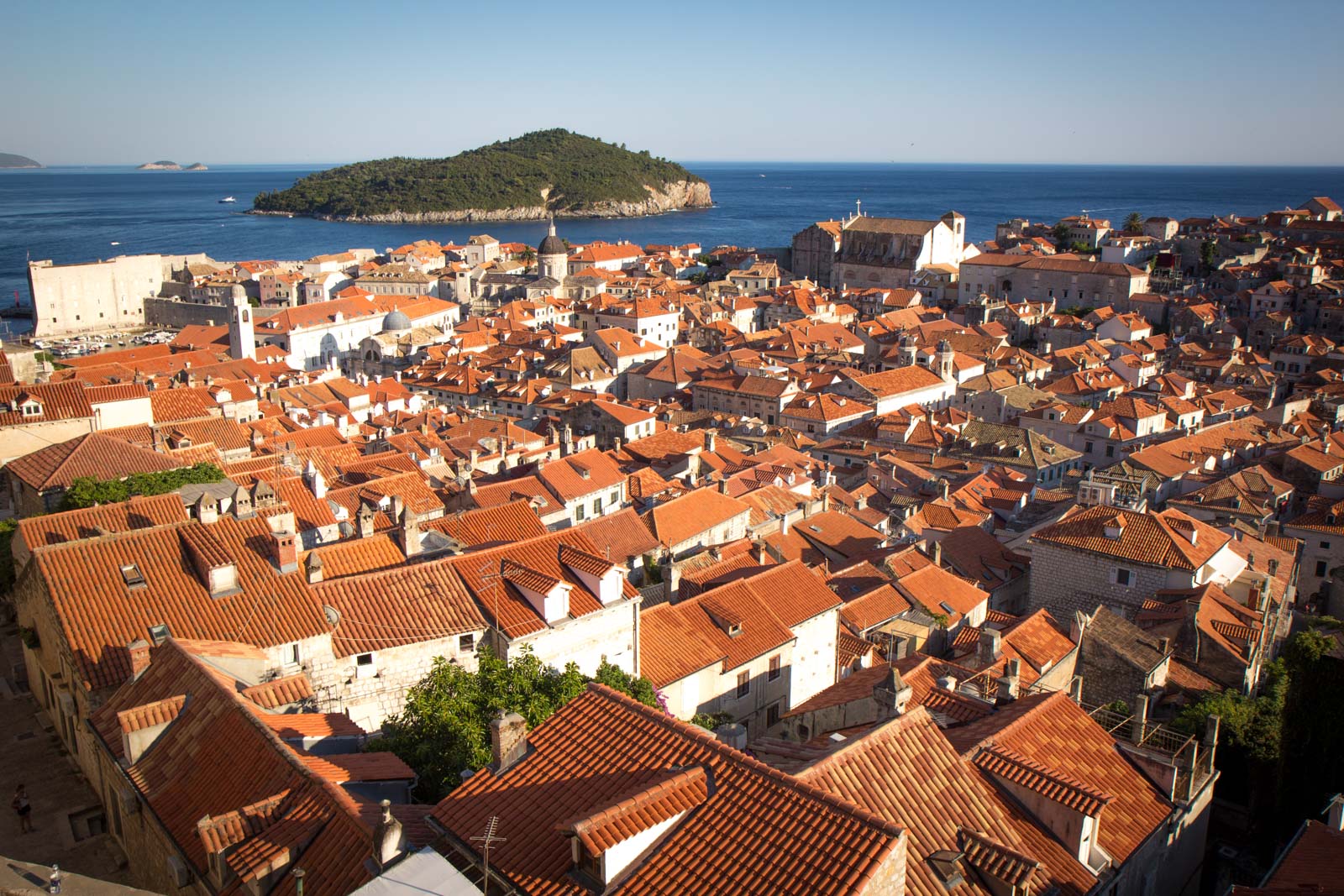
Another option is a day trip to Mostar, to see its famous Turkish bridge, along with the other sights of this World Heritage city. To do that, thereís this tour to Mostar from Trogir.
And you can even go up to äibenik and Zadar with this private transfer from Trogir, although I think it could be better to rent a car for that journey.
THE BEST ACCOMMODATION IN TROGIR
Although Split is close enough, it can be a bit more peaceful to stay around Trogir itself.
BACKPACKER

Set on ?iovo Island, Hostel Marina Trogir has lovely views across the water to the Old Town.
BUDGET
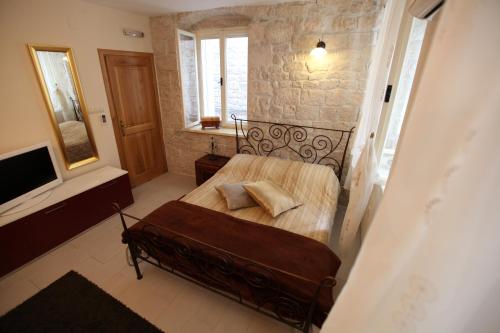
The historic stone walls give†Tragurium Salona†a sense of heritage, just a few minutes away from the beach.
BOUTIQUE
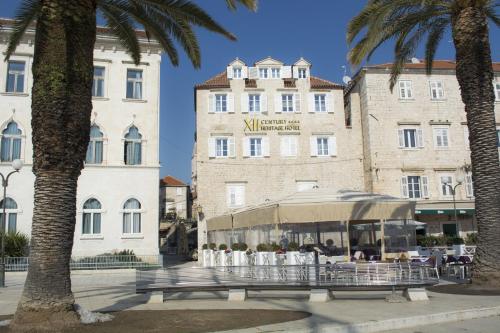
Right in the heart of the Old Town, the charming†XII Century Heritage Hotel†has quiet and comfortable rooms.
LUXURY
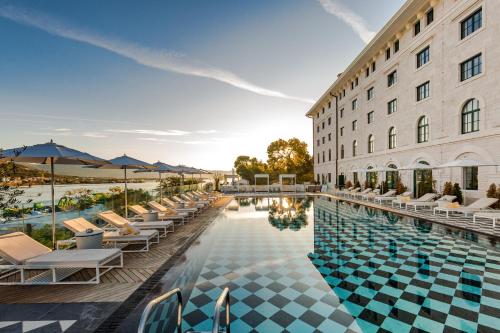
Across the water from the Old Town, the amazing†Brown Beach House†has an incredible outdoor pool.
The post Things to do in Trogir appeared first on Time Travel Turtle.







